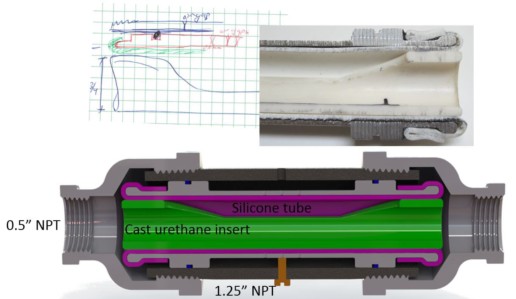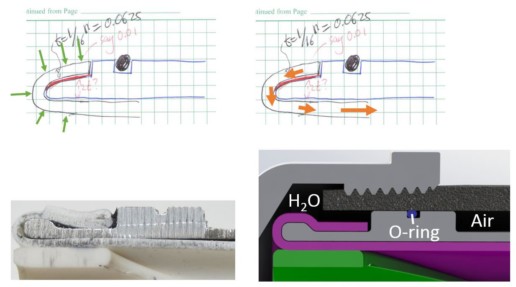Increased Durability
Problem: If a leak ever developed into the reference pressure chamber from the valve, it would increase the reference pressure and the valve would fail closed – cutting off a family’s water supply. Further, the cast urethane threads were not durable enough for installation in metal pipe networks.
Analysis: Typical (metal) pipe threads serve two functions: they transmit installation and residual forces, and they seal the pipes together. If I took the stabilizing insert out of the force transmission loop, it would increase the design and material freedom. However, this would require an internal seal between the force transmission elements and the actuation module.
Solution: For ease of manufacturing and sealing, the wire mesh was replaced with an aluminum tube with perforations. This tube sealed against an exterior pipe shell that also had perforations. Glues which met NSF61 requirements for drinking water contact and could bond silicone and aluminum were not strong – especially in peeling. An innovative joint suggested by my advisor kept the joint in shear during both positive and negative pressure loading.
Remaining Issues: Everyone in India who saw this version of the design gave the same feedback: ‘it is too heavy, it will be stolen [for its scrap metal value].’ This critique also highlighted that the design would be too expensive to manufacture.
Other Design Stages: The overview of this design is here. But more detailed entries about other design stages are linked to below:
- Problem Analysis & Initial Strategy Selection – choosing a pressure sustaining valve
- Concept Generation and Selection – choosing a Starting resistor
- Concept Refinement – inventing a stabilized Starling resistor
- Tamper Proofing – separating the user from the sensitive parts
- Increasing Durability – moving away from plastic parts
- Decreasing Costs – reducing the part count and complexity
- Field Testing – verifying performance in Delhi


